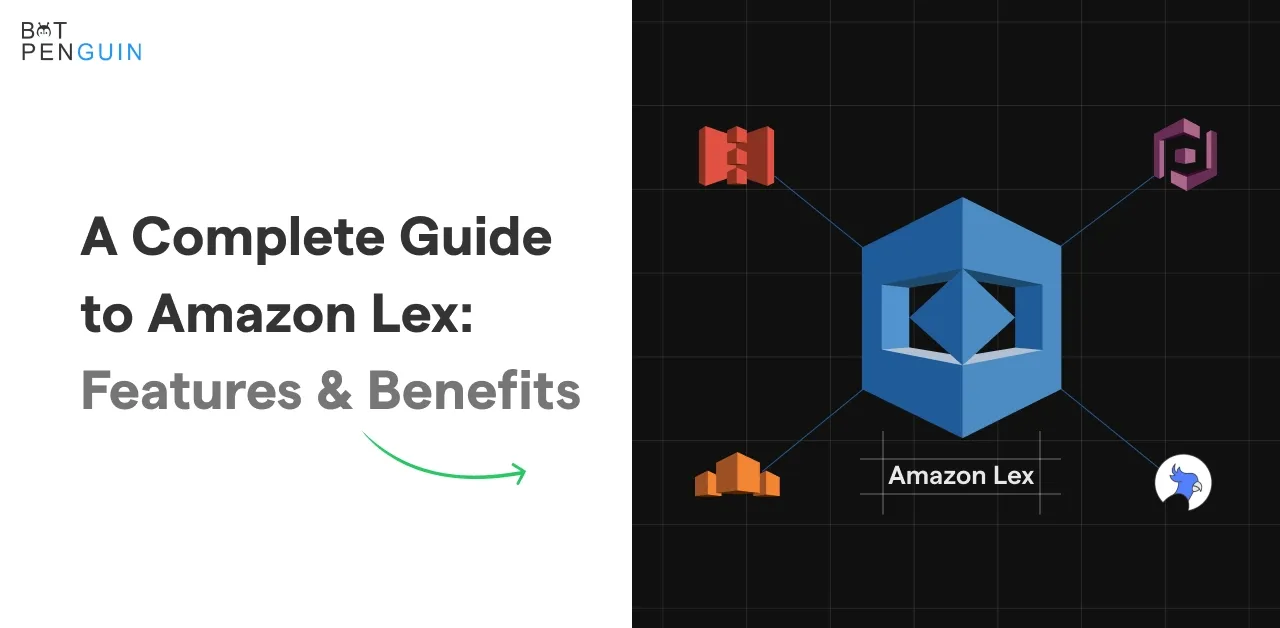Amazon Lex is the public version of the technology that powers Amazon's Alexa assistant. It comes with automatic speech recognition (ASR) and natural language understanding (NUR), found in Amazon and third-party hardware.
Additionally, it allows algorithms to comprehend natural human language, making interaction more varied.
Customer assistance, application / transactional bots (automating operations like placing an order or making a reservation), and a control bot sending and interpreting commands for Internet of Things (IoT) devices may benefit from Amazon Lex.
Amazon Lex interaction is now available through other AWS services or Facebook Messenger, with support for Slack on the way.
Note that Amazon Lex is not the same as the Alexa Skills Kit, which is for developers who wish to create an integration with the Alexa assistant available on smart home devices.
Key features of Amazon Lex
High-quality speech recognition and natural language understanding
Amazon Lex delivers automatic speech recognition and natural language understanding capabilities to construct a Voice Language Understanding system. The same technology that powers Alexa is used to power Amazon Lex. Based on a few example utterances supplied by the developer, Amazon Lex can understand the various ways users might communicate their purpose. The spoken language understanding system accepts natural language voice and text input deciphers its purpose and then invokes the appropriate response to meet the user's goal.
Management of the context
Identifying statements as the conversation progresses appropriately necessitates managing context over several turns. Amazon Lex has built-in context management, so you don't need coding.
8 kHz telephony audio support
The Amazon Lex speech recognition engine was trained on telephony audio (8 kHz sample rate), improving speech recognition accuracy for telephony use-cases. A conversational bot that uses the 8 kHz capability enhances the quality of interaction with your customer.
Multi-turn dialog
Multi-turn dialogues are possible with Amazon Lex bots. Users will be requested for necessary information for the intent to be completed once it finds it. For example, if the objective is "Book hotel," the user is prompted for the location, check-in date, number of nights, and so on). Amazon Lex makes it simple to create multi-turn dialogues for chatbots. You list the slots/parameters and prompt you to want to gather from your bot users. Amazon Lex takes care of organizing the conversation by prompting for the right slot.
Powerful Lifecycle Management Capabilities
You may use Amazon Lex to add versioning to your Intents, Slot Types, and Bots. In a multi-developer environment, versioning and rollback capabilities make it simple to maintain code while testing and deploying. You may give each Amazon Lex bot numerous aliases and assign different versions to them, such as "production," "development," and "test." It allows you to keep improving and changing the bot and releasing new versions under the same pseudonym. You don't need to update all clients when you roll out a new bot version.
One-click deployment to multiple platforms
Amazon Lex makes it simple to publish your bot to chat services straight from the Amazon Lex dashboard. It saves you time and money on multi-platform development. Rich formatting features provide chat services like Facebook Messenger, Slack, and Twilio SMS with a natural user experience.
Streaming conversations
Pauses and interruptions are common in natural talks. For example, a caller may request to pause a discussion or put it on hold. At the same time, they hunt for the relevant information before answering a question about retrieving credit card information for bill payments. You may stop a chat and manage interruptions directly by configuring the bot using streaming conversation APIs. Virtual contact center agents or intelligent assistants can swiftly improve their conversational capabilities.
Integration with Amazon Kendra
Finding particular facts to address specific queries is common in customer support talks. Amazon Kendra is a machine-learning-powered intelligent search service that is very accurate and simple. Add a Kendra search purpose to obtain the most accurate answers from unstructured materials and FAQs. To increase the bot's informative capabilities, define the search index parameters in the intent as part of the bot specification.
Integration with Amazon Polly
Amazon Polly converts text into natural-sounding voice, allowing you to create talking apps and new categories of speech-enabled devices. Polly used to reply to users during speech interactions. In addition to standard TTS voices. Amazon Polly now provides Neural Text-to-Speech (NTTS) voices, which use a novel machine learning technique to improve speech quality.
Integration with AWS Lambda
For data retrieval, updates, and business logic execution, Amazon Lex has a seamless interaction with AWS Lambda. The serverless compute capacity lets you focus on bot development while your business logic executes at scale. You can link AWS Lambda with your current corporate apps and databases using Lambda. You write your integration code, and AWS Lambda executes it anytime data is sent or received from any external system. Various AWS services, such as Amazon DynamoDB for storing discussion state and Amazon SNS for informing end-users, are also available.
Amazon Connect
Amazon Lex comes pre-integrated with Amazon Connect. It is an omnichannel cloud contact center that allows developers to create chatbots. These bots can answer consumer questions through chat or phone. The APIs will enable you to integrate Amazon Lex into any call center application. To learn more, go to Amazon Connect integration.
Contact Center Intelligence on AWS (CCI)
Several AWS CCI partners utilize Amazon Lex so that you can construct self-service customer care and virtual agents. Also, you can create informative bots and application bots with ease. Infosys, Quantiphi, and Xapp.ai are among Amazon Lex's partners. Visit the AWS CCI and AWS CCI Partners pages for further information.
Version Features of Amazon Lex

Version 0.15.0
- Upgraded to Webpack 4
- They Changed the default value of ShowResponseCardTitle from true to false.
- The default parameter BotAlias of '$LATEST' has been restored. The alias' $LATEST' should be used solely for manual testing. The amount of runtime queries you may make to the $LATEST version of Amazon Lex is limited.
Version 0.16.0
- Cloudfront is now the default distribution mechanism for Lex-web-UI. It results in faster load times, non-public access to S3 buckets, and improved future interaction with CloudFront capabilities like WAF and Lambda@Edge.
- It is no longer the latest version.
Version 0.17.0
- There are More Accessibility and screen reader functions.
- Comes with Stack outputs for CloudFront and S3 bucket to CloudFormation.
- Prioritize the response card specified by the session property "appContext" above the response card defined by Lex.
- When you define the response card in the session attributes "app context," lex web UI now supports more than five buttons.
- They Updated Dependabot security alerts-identified dependant packages in package-lock.json.
- Additional CloudFront CORS problems got resolved.
Version 0.18.0
- Upgrade the lex-web-UI component from Webpack V3 to Webpack V4.
- Upgrade to version 7.10.0 of npm.
- Ensure that component package versions are up to date.
- Take care of dependabot warnings.
- Fix for the Cognito Supported Identity Providers that resets to simply Cognito after an upgrade. The existing Supported Identity Providers remain the same after an upgrade.
- Set the AWS SDK to 2.875.0.
- Improve Lex V2 support for responseCard, which is defined as a session attribute in sessionAttributes.appContext.responseCard in sessionAttributes.appContext.responseCard.
- There is No More Support for AWS Mobile Hub-based distribution.
Version 0.19.0
- The option to send conversation history as a transcript to an agent when Connect Live Chat became available is one of two new features in version 0.19.0.
- The Connect Live Chat Agent Readme contains information on using the transcript.
- The OPTIONS method in the API has been updated only to accept requests from the WebAppParentOrigin in this version.
Benefits of Amazon Lex
Ease of Access
Amazon Lex provides a simple dashboard that guides you through the process of creating your chatbot in minutes and incorporating conversational interfaces into your apps. You have to give a few example sentences. It will create a completely natural language model with which your customer can interact in various ways and execute complex tasks.
Seamless deployment and scaling
You can officially design, test, and deploy your chatbots from the Amazon Lex interface. It enables you to publish voice or text chatbots to mobile devices, online apps, and chat services such as Facebook Messenger, Slack, and Twilio SMS. When your bot is delivered, it uses voice or text input to converse with your end-users. Because Lex is a fully managed service, you won't have to worry about over-provisioning hardware and managing infrastructure. You can enhance your bot experience as your client commitment grows.
Built-in integration with the AWS platform
Amazon Lex works with a variety of AWS services, including Amazon Cognito, Amazon CloudWatch, AWS Lambda, and AWS Mobile Hub, to name a few. The AWS platform's power may benefit from the security, monitoring, client authentication, business logic, storage, and mobile app development.
Cost-effectiveness
You won't find any hidden costs or minimum charges with Amazon Lex. You will be paid separately for any text or speech requests you make. The service's pay-as-you-go pricing and low per-request expenses make it cost-effective to create conversational interfaces. With its free tier, you can sample Amazon Lex with no underlying investment.
Use Cases of Amazon Lex
Call Center Bots
Callers may accomplish operations such as changing passwords, seeking account balances, and arranging appointments without speaking to an agent. These chatbots use automatic voice recognition and natural language comprehension to grasp the caller's expectations.
They can understand the guest's intent without requiring them to speak in precise words and perceive human speech at an optimal (8 kHz) telephony audio sample rate. Amazon Lex uses AWS Lambda functions to interrogate your business systems, return data to callers, and make modifications as needed. Amazon Lex chatbots also keep track of context and speech, altering replies dynamically as the discussion progresses.
Informational Bots
You may use Amazon Lex to build chatbots for typical customer demands like acquiring the latest news, gaming scores, or weather information. With support for rich message formatting, you may deploy your Amazon Lex bot on mobile phones, chat services, and IoT devices once you construct it.
Application Bots
The high-quality speech recognition and NLU capabilities of Amazon Lex make it possible to create unique mobile app experiences. Bots on mobile devices can feature a voice or text chat interface to assist customers with various simple tasks. For example: accessing their bank accounts, calling a cab, booking tickets, and buying meals. With Amazon Lex's integration with Amazon Cognito, you can govern user management, authentication, and sync across all devices.
Enterprise Productivity Bots
You may use Amazon Lex to create workplace chatbots that automate routine tasks and increase organizational efficiency. Employees may, for example, examine sales statistics from Salesforce, customer support status from Zendesk, and marketing performance from HubSpot directly from their chatbots in a matter of seconds. With Amazon Lex, you can use AWS Lambda functions to connect your bots to various corporate business productivity solutions.
Internet Of Things (IoT)
You can create highly engaging and conversational user experiences for linked devices with Amazon Lex in the rapidly growing Internet of Things segment (IoT). It paves the way for new conversational products in various areas, ranging from automobiles and electronics to wearables and appliances.
Conclusion
Amazon Lex is a software to build conversational features on AWS. You can see this in Alexa. With deep learning power, natural language understanding, and automatic speech recognition, it has shown promise. It comes as a service platform that any developer can use to build chatbots. Additionally, you can launch your chatbot to chat service directly from the Amazon Lex consoles. You don't have to go through multi-platform development efforts. The sophisticated user experience from Lex gives your bot a new face. Lastly, it simplifies the deployment and management of Amazon Lex on messaging platform.
See how BotPenguin can give you an intelligent platform to provide the best experience to your consumers.











